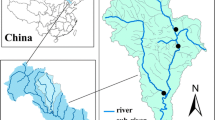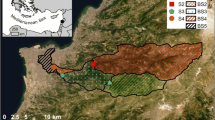Abstract
Heavy background pollutant loads pose a difficult problem for the assessment and management of regional water quality, especially in areas where surface water quality is less affected by anthropogenic pollution. Deducting background values from those derived from water quality monitoring is a new method for evaluating surface water environments in areas with heavy background loads. In this study, river source reserves in Heilongjiang province were evaluated with an export coefficient model (ECM) that considers the rainfall influence factor, has an improved timescale, and is based on synchronous rainfall monitoring data and concentrations. Moreover, the ECM was combined with a mechanism model. The chemical oxygen demand, ammonia nitrogen, and other water quality indices are affected by background environment, and therefore, suitable export coefficients for the study area were determined and a regression equation between the rainfall influence factor and precipitation was established. By combining the ECM and mechanism model, the concentrations entering the river during eight rainfall events in 2018 were predicted, and the background value was calculated to evaluate surface water quality. The predicted values were found to approximate the monitored values. Therefore, this study is of great significance for water quality assessment and management in areas with heavy background pollutant loads.






Similar content being viewed by others
References
Anna, G., Margarethe, L., Manassis, M., Anastasios, Z., Ioannis, K., & Mathias, E. (2017). Effect of organic matter on Cr(VI) removal from groundwaters by Fe(II) reductive precipitation for groundwater treatment. Water, 9(6), 389–394.
Barthès, B., & Roose, E. (2002). Aggregate stability as an indicator of soil susceptibility to runoff and erosion; validation at several levels. Catena, 47(2), 133–149.
Bissonnais, Y. L. (2010). Aggregate stability and assessment of soil crustability and erodibility: I. theory and methodology. European Journal of Soil Science, 48(1), 39–48.
Bondelid, T. R., Mccuen, R. H., & Jackson, T. J. (1982). Sensitivity of SCS models to curve number variation. Journal of the American Water Resources Association, 18(1), 6.
Burroughs, R. H. (1993). Nonpoint sources as external threats to coastal water quality: lessons from park service experience. Coastal Management, 21(2), 131–142.
Chen, Y., Yuan, Q., Han, F., Zhou, L., & Hong, S. (2017). Estimation of non-point source pollution load of Yangtze watershed based on improved export coefficient model. Journal of Geomatics, 42(1), 96–99.
Chen, Z., Liu, X., & Zhu, B. (2014). Runoff estimation in hillslope cropland of purple soil based on SCS-CN model. Trans Chin Soc Agric Eng, 30(7), 72–81.
Cheng, X., Chen, L., Sun, R., & Jing, Y. (2018). An improved export coefficient model to estimate non-point source phosphorus pollution risks under complex precipitation and terrain conditions. Environmental Science and Pollution Research, 25(21), 20946–20955.
Corbari, C., Lassini, F., & Mancini, M. (2016). Effect of intense short rainfall events on coastal water quality parameters from remote sensing data. Continental Shelf Research, 123, 18–28.
Duan, M., Du, X., Peng, W., Zhang, S., & Yan, L. (2019a). A revised method of surface water quality evaluation based on background values and its application to samples collected in Heilongjiang Province, China. Water., 11(5), 1057.
Duan, M., Du, X., Peng, W., Zhang, S., & Yan, L. (2019b). Necessity of acknowledging background pollutants in management and assessment of unique basins. Water., 11(5), 1103.
Duan, M., Du, X., Peng, W., Jiang, C., Zhang, S., (in press). Role of humic substances as refractory organic matter in sustainable water quality assessment and management. Water supply.
Delpla, I., Baurès, E., Jung, A.-V., & Thomas, O. (2011). Impacts of rainfall events on runoff water quality in an agricultural environment in temperate areas. Sci Total Environ, 409(9), 1683–1688.
Ding, X. W., Shen, Z. Y., Hong, Q., Yang, Z. F., Wu, X., & Liu, R. M. (2010). Development and test of the export coefficient model in the upper reach of the Yangtze River. Journal of Hydrology, 383, 233–244.
Dong, F., Liu, X. B., Peng, W. Q., & Wang, L. (2017). Estimation of non-point source pollution loads by improvising export coefficient model in watershed with a modified planting pattern. IOP Conference Series: Earth and Environmental Science, 82, 012068.
El Kateb, H., Zhang, H., Zhang, P., & Mosandl, R. (2013). Soil erosion and surface runoff on different vegetation covers and slope gradients: a field experiment in southern Shaanxi Province, China. Catena, 105(complete), 1–10.
Hayes, M. H. B., & Swift, R. S. (2017). An appreciation of the contribution of Frank Stevenson to the advancement of studies of soil organic matter and humic substance. Journal of Soils and Sediments, 18(4), 1212–1231.
Helles, R. (2010). Wastewater COD removal using sol-gel immobilized humic acid. J Toxicol Environ Health Sci, 2(1), 7–10.
Henry, H. A. L. (2007). Soil freeze-thaw cycle experiments: trends, methodological weaknesses and suggested improvements. Soil Biology and Biochemistry, 39, 977–986.
Jiao, J., Wang, W., & Li, J. (2000). Effective cover rate of woodland and grassland for soil and water conservation. Acta Phytoecol Sin, 24(5), 608–612 (in Chinese).
Johnes PJ (1996) Evaluation and management of the impact of land use change on the nitrogen and phosphorus load delivered to surface waters: the export coefficient modelling approach. J Hydrol (Amsterdam) 183(3–4):0–349.
Kim, D., Park, H. J., Kim, J. H., Youn, U. J., Yang, Y. H., Casanova-Katny, A., et al. (2018). Passive warming effect on soil microbial community and humic substance degradation in maritime Antarctic region. Journal of Basic Microbiology, 58(6), 513–522.
Li, J. M., & Wu, J. G. (2011). Effects of the different organic materials on the structure and elemental composition of humus in black soil. Advanced Materials Research, 356-360, 8–13.
Li, S., Zhang, L., Du, Y., Liu, H., Zhuang, Y., & Liu, S. (2016). Evaluating phosphorus loss for watershed management: integrating a weighting scheme of watershed heterogeneity into export coefficient model. Environmental Modeling and Assessment, 21(5), 657–668.
Liu, R., Dong, G., Xu, F., Wang, X., & He, M. (2015). Spatial-temporal characteristics of phosphorus in non-point source pollution with grid-based export coefficient model and geographical information system. Water Science and Technology, 71(11), 1709–1717.
Ritchie, J. D., & Perdue, E. M. (2003). Proton-binding study of standard and reference fulvic acids, humic acids, and natural organic matter. Geochimica et Cosmochimica Acta, 67(1), 85–96.
Silva, C. P., Lima, D. L. D., Groth, M. B., & Otero, M. (2016). Effect of natural aquatic humic substances on the photodegradation of estrone. Chemosphere, 145, 249–255.
Sun, G., Saeed, T., Zhang, G., & Sivakugan, N. (2015). Water quantity and quality assessment on a tertiary treatment wetland in a tropical climate. Water Science and Technology, 71(4), 511–517.
Tadesse, L., Suryabhagavan, K. V., Sridhar, G., & Legesse, G. (2017). Landuse and landcover changes and soil erosion in Yezat Watershed, North Western Ethiopia. International Soil and Water Conservation Research, 5(2), 85–94.
Taiming, W., Yeyao, W., Bao, X., & Yu, H. U. (2010). Freeze-thaw cycles effects on humic substances in typical soils in northeast China. Ecol Environ Sci, 19(12), 2870–2874.
Tong, X. X., Hu, B., Xu, W. S., Liu, J. G., & Zhang, P. C. (2017). The estimation of the load of non-point source nitrogen and phosphorus based on observation experiments and export coefficient method in three gorges reservoir area. IOP Conference Series: Earth and Environmental Science, 100, 012181.
USDA. (2012). Nationwide assessment of nonpoint source threats to water quality. BioScience, 62(2), 136–146.
Vasileva, V., & Kostov, O. (2015). Effect of mineral and organic fertilization on alfalfa forage and soil fertility. Emir J Food Agric, 27(9), 678–686.
Wang, W., Ju, T., Dong, W., Liu, X., Yang, C., Wang, Y., et al. (2015). Analysis of nonpoint source pollution and water environmental quality variation trends in the Nansi Lake Basin from 2002 to 2012. Journal of Chemistry, 16, 27015–27031.
Wei, Y., Xiaoxiao, Y., Yanping, W. U., Shiliang, L. I., & Miao, L. (2012). Based on export coefficient theory in simulating pollution load of non-point source of Shuangtaizi River. J Shenyang Jianzhu Univ, Nat Sci, 28(2), 338–343 (in Chinese).
Wu, F., Yang, W., Zhang, J., & Deng, R. (2010). Litter decomposition in two subalpine forests during the freeze–thaw season. Canadian Journal of Forest Research, 36(1), 135–140.
Wu, L., Li, P., & Ma, X. Y. (2016). Estimating nonpoint source pollution load using four modified export coefficient models in a large easily eroded watershed of the loess hilly–gully region, China. Environment and Earth Science, 75(13), 1056.
Xiao, B., Wang, Q.-H., Fan, J., Han, F.-P., & Dai, Q.-H. (2011). Application of the SCS-CN model to runoff estimation in a small watershed with high spatial heterogeneity. Pedosphere, 21(6), 738–749.
Xing L, Donglong L, Hongbo Z, Shixiang C, Xiaodong L, Tianqi A (2015) Research on nonpoint source pollution assessment method in data sparse regions: a case study of Xichong River Basin, China. Advances in Meteorology 1–10.
Zhang, C., Liu, Z., & Zhang, G. (2017). A study of the agricultural non-point sources of ammonia nitrogen load in Henan province based on the export coefficient method. China Rural Water and Hydropower, 10, 35–39 (in Chinese).
Zhang, Z. Q., Xian, W. L., Xiao, Y. X., & Klaghofer, E. (2001). Impacts of forest vegetation on runoff generation mechanisms: a review. Journal of Natural Resources, 16(1), 79–84.
Zhu, J., He, X., Wu, F., Yang, W., & Tan, B. (2012). Decomposition of Abies faxoniana litter varies with freeze–thaw stages and altitudes in subalpine/alpine forests of southwest China. Scandinavian Journal of Forest Research, 27(6), 11.
Ziyin, D. U., Yanjiang, C., Xiaodan, W., Yan, Y., Xuyang, L. U., & Shuzhen, L. (2014). Research progress on the effects of soil freeze-thaw on plant physiology and ecology. Chinese Journal of Eco-Agriculture, 22(1), 1–9.
Funding
This work was jointly supported by the IWHR Research and Development Support Program (Grant Nos. WE0145B052017).
Author information
Authors and Affiliations
Corresponding author
Ethics declarations
Conflict of interest
The authors declare that they have no conflict of interest.
Additional information
Publisher’s note
Springer Nature remains neutral with regard to jurisdictional claims in published maps and institutional affiliations.
Rights and permissions
About this article
Cite this article
Duan, M., Du, X., Peng, W. et al. Quantitative assessment of background pollutants using a modified method in data-poor regions. Environ Monit Assess 192, 160 (2020). https://doi.org/10.1007/s10661-020-8122-8
Received:
Accepted:
Published:
DOI: https://doi.org/10.1007/s10661-020-8122-8




